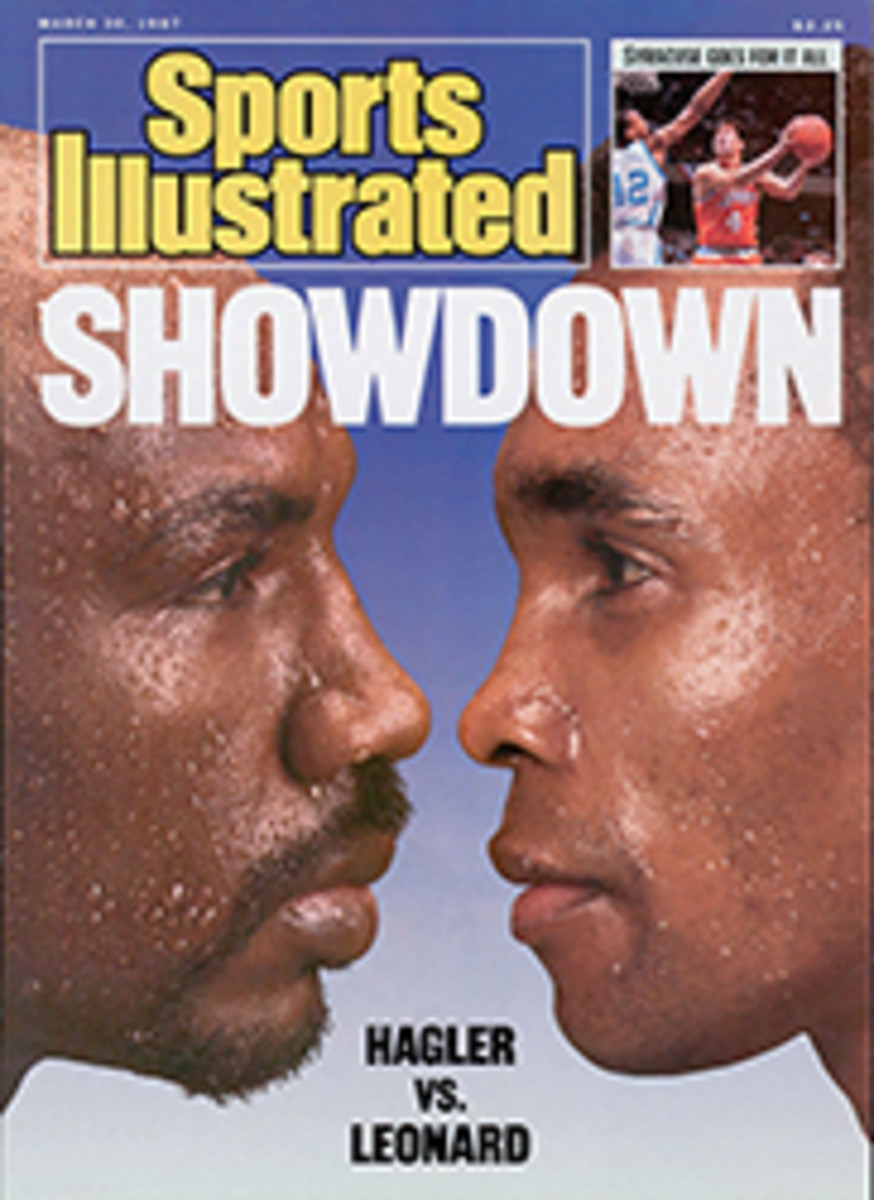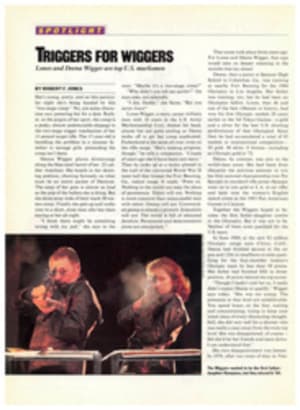
GOLF WITHOUT A CADDIE
Going into the World One Club Golf Championship, Tim Burklew had a ridiculous plan. The 26-year-old butcher from Williamston, N.C., intended to turn pro the morning of the 18-hole tournament. He planned to hit some shots farther than anyone else and to hit some shots shorter than anyone else. And—oh, yes—he would get down on his knees to putt.
The most ridiculous part of this plan is that it worked. In the fifth edition of the One Club Championship, held last October at the Lochmere Golf Club near Raleigh, N.C., Burklew broke the world record and beat the field of 105 by one stroke. Using a six-iron, he shot a 72 to become the first player ever to officially equal par with a single club, sealing his $11,000 victory with a miraculous sand shot on the final hole.
Burklew's par 72 was impressive, for playing with only one club is as demanding as it sounds. Like Burklew, most players choose a middle iron for versatility, but with that club they have trouble hitting approach shots high enough to hold a green, and they have problems making putts that don't squirt off the club face.
These difficulties were spotlighted in the One-Club Challenge, an exhibition held after the 1984 British Open at St. Andrews. Six top pros struggled with their pitches, blasts and putts, and their scorecards were littered with bogies. In the featured nine-hole match between two experienced one-club players, Seve Ballesteros finished three over par and Lee Trevino was five over.
Burklew was an unlikely candidate to set a world record. Before the One Club Championship he was too obscure even for a trivia question. He played one year at Florida Tech in Melbourne, then dropped out of school to earn some money. He moved to Williamston, where he bought a mobile home and got a job carving meat at the Be-Lo Supermarket.
But Burklew showed talent playing with a full bag. The 5'9", 200-pound native of Florida could drive more than 300 yards. Utterly self-confident, he broke course records at two North Carolina courses, High Hampton Golf Club and Roanoke Country Club, with 64s. His long game was accurate—no, the butcher didn't slice—but he admits, "My putting was atrocious."
One-club golfers usually putt by chipping, or striking the middle of the ball with the bottom of the club face, or they reverse their stance and hit with the back of the club head. But Burklew had a better idea.
Since his putting couldn't bring the course to its knees, he would bring his knees to the course. Kneeling on his living-room floor, Burklew tried about 15 different grips on his six-iron. He settled on overlapping the shaft just below the leather with his left hand and placing his right fingertips on the bottom of the shaft, with his index finger behind the club head. He lined the ball up with his right knee, closed the club face and took a normal putting stroke.
"I practiced in my mobile home for some three hours every night," says Burklew. "I could putt up to 40 feet—a machine returned the ball. I couldn't practice at the local course. People there laughed at me."
Because no one uses a caddie to carry a single club, Burklew couldn't get advice about the Lochmere course during the competition. As tournament director Rene Miller said, "The only caddie at Lochmere is going to be my Eldorado." So Burklew played a practice round to study the tight, wooded course.
Cleverly, he positioned his ball on long holes so that he could hit to the greens with his usual six-iron swing. On every par 5 or long par 4 he selected a target area 165 yards from the pin and described it in a tiny notebook.
Before the championship began, Burklew seemed just another underdog bound for the pound. In the field of invited players and qualifiers from seven regional tournaments the clear favorite was Thad Daber, the defending champion. Daber is everything that Burklew is not. He is a successful investment counselor who drives a wine-red Mercedes. The 6-foot tall, 140-pound, 27-year-old is as skinny as his six-iron; when he impishly gave his weight to a reporter as 190 the reporter asked, "Do you mean ounces?"
A local celebrity, Daber played for N.C. State in Raleigh. He went on the international pro tour, then settled in nearby Durham. At the One Club in 1985 he shot a 73 to finish five strokes ahead of PGA touring pros Bobby Clampett and John Fought and two ahead of Vance Heafner.
By contrast, Burklew arrived on the Sunday morning of the tournament as a mystery man. When he greeted Miller with a crushing handshake the tournament director recoiled, wondering, Who is this guy?
At the scorer's table Burklew signed an affidavit renouncing his amateur status. Although invited as an amateur, Burklew, who hopes to go on the pro minitour this summer, was allowed to compete as a pro. Pro-am teams were scattered around the course for the start, and Burklew's group began on the 16th. The greens were damp, so at first he putted from a standing position to strike the ball more solidly. He missed a short putt on each of the first three holes and went two over par.
From then on Burklew stayed with his original plan. At the next hole, a par 5, he uncorked a 230-yard drive, the longest anyone would hit all day. He punched a positioning shot less than 100 yards from his target area, then hit the pin with his approach shot. Planting himself on his knees, he knocked in the birdie putt.
When Burklew knelt to putt on his sixth hole, a disbelieving player in the group behind him yelled, "What are you doing—praying?"
But Burklew kept his cool. On his 10th hole, a 155-yard par 3, he landed two feet from the cup and collected another birdie. On his 11th, a 428-yard par 4, he reached the green in two, a feat tour pro Fought had called impossible with a six-iron.
Still, the butcher remained anonymous. When he asked a newspaper photographer to take his team's picture at his ninth hole, he was rebuffed.
"We'll pay for it," said Burklew.
"I can't do it," said the photographer. "I've got to find Thad Daber."
"You'll be sorry," Burklew called after him.
Burklew made good on his boast. He went to his closing hole at even par. So far, he had one-putted nine times, sinking five putts of 15 feet or more.
"I knew I had to have a par 4 to break the world record," says Burklew. As it turned out he also needed a par to win the tournament.
Behind him Daber was finishing at one over par. During his round Daber had sunk an 80-foot chip shot and holed out a bunker shot that he intentionally ricocheted off a bank. And Daber was matched by Bob Garza, 27, from Oxnard, Calif. A short, moon-faced pro garbed in purple slacks, Garza hit 14 greens in regulation with his five-iron.
Too pumped up, Burklew hit his final tee shot 25 yards past his target area. His next shot courted disaster—he left the ball near an island in the bunker fronting the green.
Burklew perched his left foot on the island and worked his right into the sand. He saw a pond lurking behind the green but ignored it. Why worry about the water? he thought. If I mis-hit this blast, it's going 200 yards.
He laid the face of his six-iron wide open, then swung fiercely. The ball neatly popped seven feet in the air, hit past the pin and drew back a foot from the cup. Burklew dropped to his knees and tapped in the winner.
The Be-Lo butcher had brought home the bacon.
PHOTO
BILL BALLENBERG
Burklew had an unusual putting position, but by tournament's end nobody was laughing.
Arnold Schechter, a freelance writer, plays best with a four-iron and a tail wind.

